Gain insights into the intriguing debate over the Bible's scientific narratives and what they reveal about faith versus fact.

Scientific Inconsistencies in the Bible
While some argue that the Bible isn't meant to be a scientific text, it's fascinating to observe how its narratives intersect with modern scientific understanding. You've likely heard debates on topics ranging from the creation versus evolution discussion, the age of the Earth, to the feasibility of a global flood.
These subjects, along with claims about human lifespans and astronomical descriptions, invite a closer look. By exploring these areas, you're not just engaging with ancient texts; you're participating in a broader conversation about faith, science, and the interpretation of history. What you uncover may surprise you, shedding light on the complex relationship between faith and reason.
Key Takeaways
- Biblical chronology conflicts with scientific estimates of Earth's age, approximately 4.54 billion years.
- Global flood narratives lack support from consistent worldwide sedimentary evidence and genetic diversity data.
- The Bible's depiction of human lifespan, such as Methuselah's age, contradicts known genetic and evolutionary mechanisms for longevity.
- Astronomical observations, including the age and scale of the universe, challenge the young universe implied by biblical texts.
Creation Versus Evolution
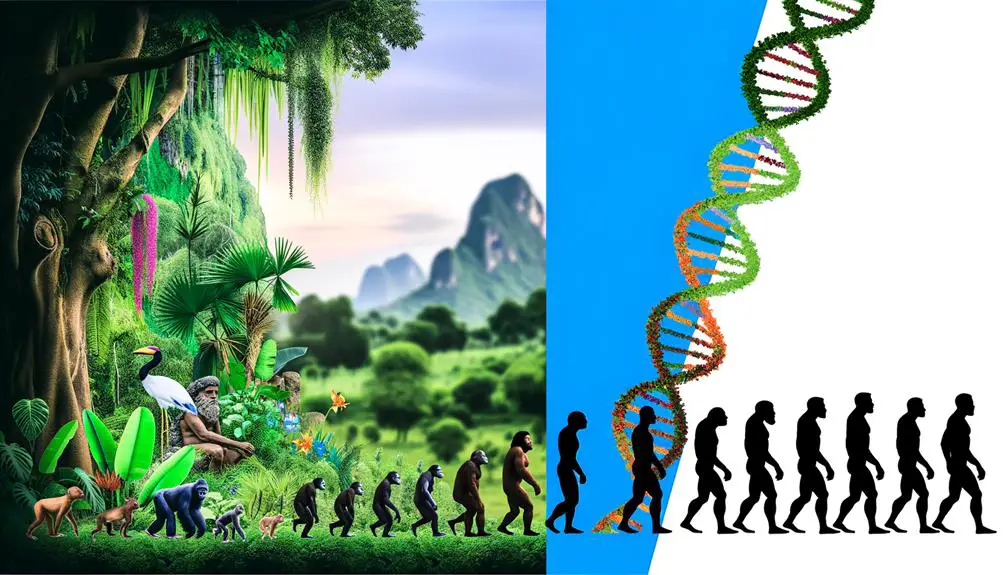
The debate between creation as depicted in the Bible and the scientific theory of evolution presents a significant clash of ideologies, challenging individuals to examine the evidence and reasoning behind both perspectives. You're faced with a key question: How did life as we know it come to be? Creationism posits that a divine being intentionally created the universe and all living things in their current form, as narrated in the Bible. In contrast, the theory of evolution, grounded in scientific evidence, suggests that life has evolved over billions of years through natural processes like natural selection and genetic diversity.
When you delve into genetic diversity, it becomes evident how evolution provides a robust explanation for the variety of life forms on Earth. Genetic variations within populations of organisms have been observed and documented extensively, supporting the idea that these variations can lead to significant changes in species over time through natural selection. This concept illustrates how traits beneficial for survival in an organism's environment are more likely to be passed down through generations, leading to evolutionary change.
The principle of natural selection, a cornerstone of the theory of evolution, offers a logical explanation for the adaptation and survival of species in response to their environments. This contrasts with the creationist view, which doesn't account for the observable genetic diversity and evolutionary adaptations seen within the natural world.
Understanding these concepts requires you to critically analyze the evidence and arguments presented by both sides. It's about weighing the scientific evidence for evolution against the biblical account of creation, considering the implications of genetic diversity and natural selection in shaping the world we see today.
Age of the Earth
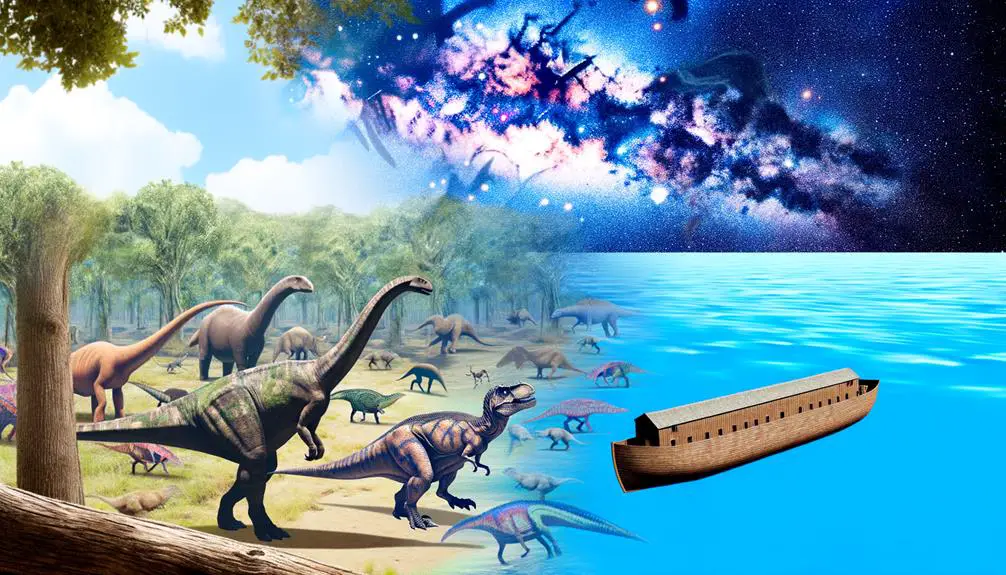
You'll find that biblical chronology presents an age of the Earth that starkly contrasts with scientific estimates. This discrepancy raises questions about the interpretation and understanding of ancient texts when compared to modern geological and astronomical evidence.
Exploring these challenges provides insight into the complex relationship between faith-based narratives and empirical scientific findings.
Biblical Chronology Challenges
One of the most debated aspects within biblical chronology is the age of the Earth, with interpretations varying widely among scholars and religious texts. This debate often centers around two key issues: genealogy gaps and king timelines. These elements contribute to the difficulty in pinpointing an exact age for the Earth based on biblical records alone.
- Genealogy Gaps: You might feel puzzled by the missing links in biblical genealogies, which create uncertainty in the historical timeline.
- King Timelines: Conflicting reign durations of kings add to the complexity, making you question the chronological consistency.
- Scholarly Interpretations: Diverse scholarly opinions can leave you feeling conflicted over which interpretation to trust.
- Religious Text Variations: Variations in religious texts might evoke frustration over the lack of a unified stance on the Earth's age.
Scientific Age Estimates
In contrast to biblical chronologies, scientific methods estimate the Earth's age at about 4.54 billion years, providing a starkly different perspective. You're diving into a realm where evidence and data guide conclusions, far from the literal interpretations of ancient texts.
Scientists rely on carbon dating and radiometric techniques to gauge the planet's age. These methods aren't just guesses; they're based on the steady decay rates of radioactive isotopes found in rocks and fossils. While carbon dating is vital for determining the age of relatively recent artifacts and remains, it's the broader suite of radiometric techniques that pinpoints the Earth's much older birthday.
This approach offers a meticulous and repeatable framework for understanding our planet's ancient history, a narrative deeply rooted in physical evidence rather than allegorical accounts.
Global Flood Debate
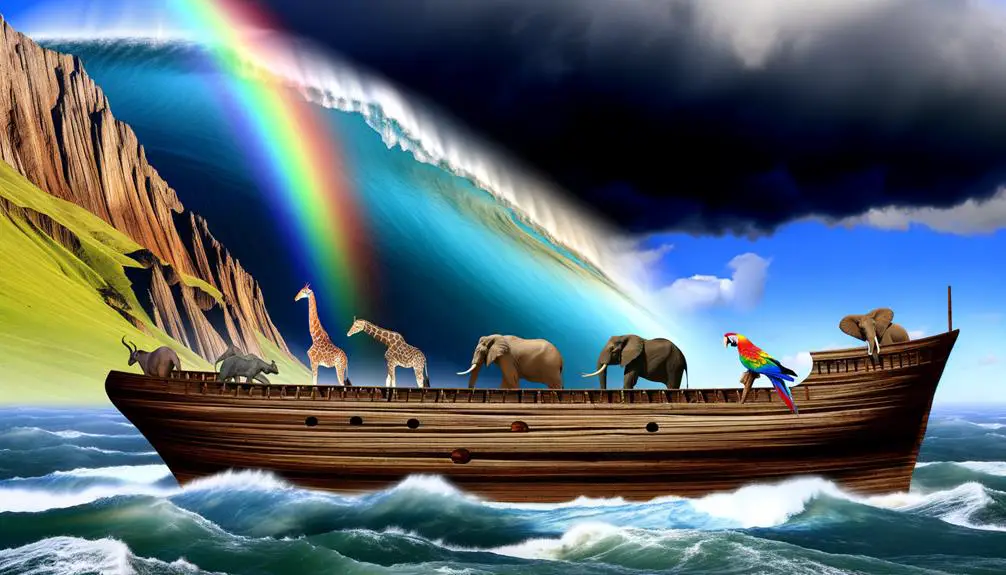
Many scholars and scientists debate the feasibility of a global flood as described in the Bible, considering geological and archaeological evidence. This debate often centers on two key topics: Flood geology and the Ararat anomaly. Flood geology proposes a geological explanation for the flood narrative, suggesting a cataclysmic event reshaped Earth's surface. Meanwhile, the Ararat anomaly, a feature observed on Mount Ararat, where the Bible suggests Noah's Ark came to rest, sparks curiosity but remains unverified by mainstream science.
The discussion around a global flood raises several points of contention:
- Geological Evidence: There's a lack of consistent, worldwide sedimentary layers that would indicate a global flood. Instead, geological records show a diverse history of local floods.
- Species Distribution: The rapid repopulation and distribution of species across continents following a global flood challenge existing knowledge of biology and ecology.
- Cultural Continuity: Archaeological records from civilizations around the world show uninterrupted human activity through the supposed time of a global flood, contradicting the idea of a civilization-ending event.
- Genetic Diversity: The genetic variance observed in humans and other species today would be difficult to achieve if all life descended from the survivors of a singular global flood.
The debate over the global flood narrative highlights the complexities of reconciling religious texts with scientific understanding. While faith and science each serve distinct roles in human society, the intersection of the two often prompts deep reflection and dialogue.
Human Lifespan Claims
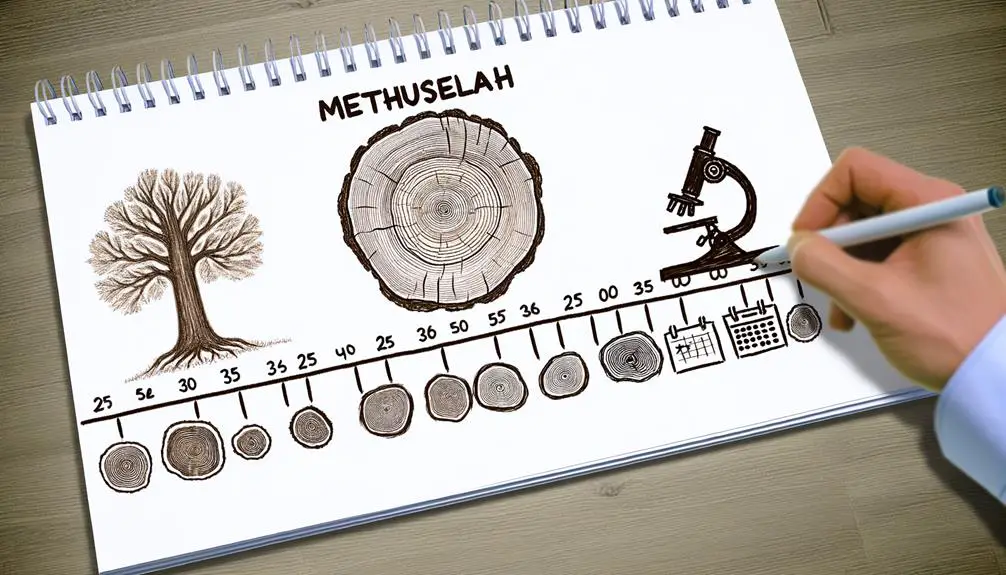
You may find it intriguing that the Bible mentions individuals living to ages far beyond today's human lifespans, with Methuselah famously cited as reaching 969 years.
This claim contrasts sharply with scientific evidence on the evolution of human lifespans, indicating a much shorter life expectancy for ancient humans.
Your understanding of these discrepancies invites a closer examination of how literal interpretations of biblical ages align with our current scientific knowledge.
Methuselah's Age Debate
The age of Methuselah, reported as 969 years in the Bible, sparks considerable debate among scholars regarding the plausibility of human lifespans in ancient texts. This narrative isn't just a tale; it's a profound exploration of genealogical symbolism and historical context, challenging your understanding of ancient storytelling.
- Genealogical symbolism: Methuselah's age may represent something beyond a literal number, symbolizing wisdom or virtue.
- Historical context: Lifespan figures in ancient texts often carry metaphorical or allegorical meanings.
- Scientific scrutiny: Modern science questions the biological feasibility of such extended lifespans.
- Cultural comparisons: Other ancient cultures also have records of exceptionally long lifespans, suggesting a common literary or symbolic motif.
Analyzing this through an objective lens invites a deeper understanding of the intersection between faith, history, and science.
Lifespan Evolution Evidence
While exploring Methuselah's age offers insights into the symbolic and historical aspects of ancient texts, examining the evidence for human lifespan evolution sheds light on how our understanding of longevity has been shaped by scientific discoveries.
You'll find that genetic mutations play a pivotal role in this narrative. These mutations, accumulated over generations, haven't only influenced the diversity of human traits but have also impacted our health and lifespan.
Modern longevity, as you observe, is a product of both genetic inheritance and advancements in healthcare, nutrition, and living conditions. This complex interplay underscores the importance of viewing biblical lifespan claims through a lens of symbolic meaning rather than literal historical fact, highlighting the distinction between ancient texts and contemporary scientific understanding of human longevity.
Astronomical Descriptions
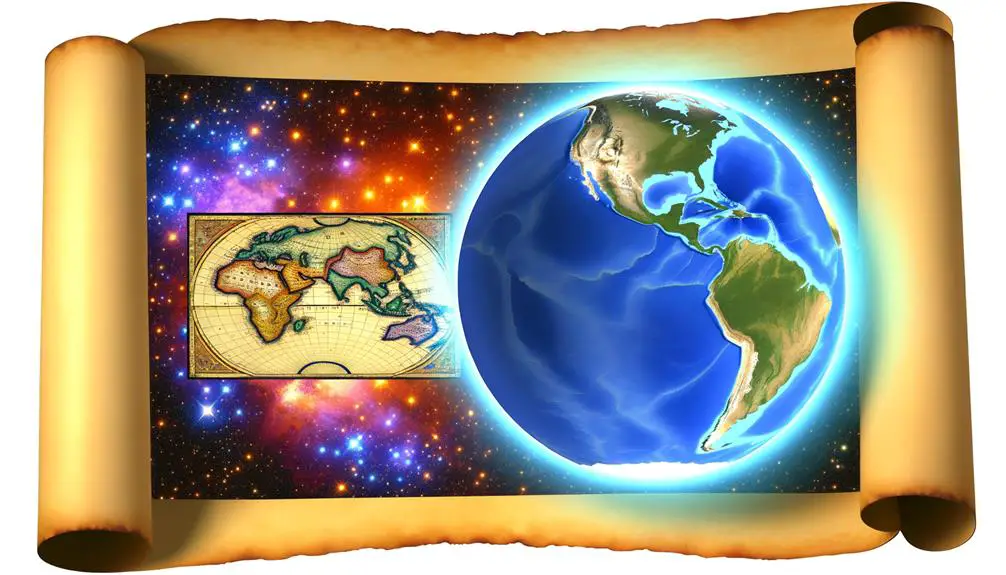
Several astronomical descriptions in the Bible raise questions about their accuracy when compared to modern scientific understandings. Two primary areas of contention include the starlight problem and the firmament concept. Let's delve into why these descriptions can evoke a deep emotional response:
- Starlight Problem: The Bible implies a young universe, yet the light from distant stars has traveled billions of years to reach us. Understanding this discrepancy can make you feel a profound sense of wonder about the vastness of the universe and question the literal interpretations of ancient texts.
- Firmament Concept: The Bible describes a firmament, a solid dome over the Earth, holding back waters. This contradicts the known reality of space, causing a mix of fascination and disbelief as you realize how our ancestors tried to make sense of the world above them.
The starlight problem directly challenges the timeline of creation as described in biblical texts. Modern astronomy and the observable universe suggest an age of approximately 13.8 billion years, a stark contrast to the biblical account which implies a much younger Earth and universe. This discrepancy isn't just a matter of numbers; it's a challenge to the way we reconcile faith with scientific evidence.
The firmament concept, on the other hand, reflects the ancient understanding of the cosmos. Today, we know there's no solid dome above us, but a vast, expanding universe. This knowledge shifts our perspective, urging us to consider how interpretations of sacred texts evolve with our understanding of the cosmos.
These examples highlight the tension between faith and science, encouraging a deeper exploration of both realms.
Nature of Miracles
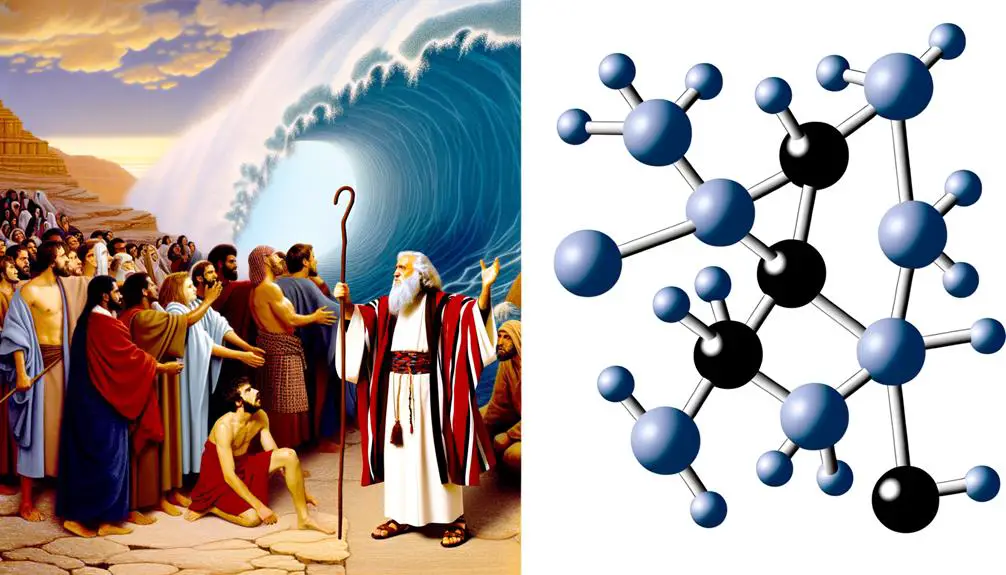
In exploring the nature of miracles, it's crucial to understand their role as extraordinary events that defy conventional scientific explanations. These occurrences, often cited in religious texts like the Bible, challenge our understanding of natural laws. The tension between faith and science emerges when attempting miracle verification, as the scientific method relies on observable, repeatable phenomena, whereas miracles are, by definition, exceptional and often singular events.
Aspect |
Science Perspective |
Faith Perspective |
|---|---|---|
Basis |
Empirical evidence |
Spiritual belief |
Verification |
Reproducibility |
Witness accounts |
Explanation |
Natural laws |
Divine intervention |
Acceptance Criteria |
Peer review |
Doctrinal support |
Outcome |
Theoretical revision |
Strengthened belief |
This table highlights the fundamental differences in approach between faith and science when considering miracles. Science seeks explanations within the framework of existing knowledge and observable evidence, leading to a natural skepticism towards miracles. Faith, on the other hand, accepts miracles as manifestations of the divine, beyond the need for empirical proof.
The debate between faith vs. science in the context of miracles is not about disproving one another but understanding the limitations and scopes of both perspectives. While science may never fully embrace miracles due to the lack of verifiable evidence, faith communities view them as essential elements that reinforce beliefs and values. Ultimately, the nature of miracles invites us to consider a broader view of reality, one that encompasses, rather than excludes, the mysteries that remain beyond our current scientific understanding.
Frequently Asked Questions
How Do Various Religious Scholars Reconcile the Scientific Inconsistencies Present in the Bible With Their Faith?
You're curious about how religious scholars bridge their faith with challenging questions. They turn to allegorical interpretations and historical context to find harmony. Essentially, they see biblical stories not always as literal facts but as moral or spiritual lessons.
In What Ways Have Modern Scientific Discoveries Impacted Theological Interpretations of the Bible?
Modern scientific discoveries have significantly impacted theological interpretations of the Bible.
You'll find that scholars now emphasize cultural context and historical analysis more than ever. This approach helps them understand the Bible's messages within the time it was written, rather than through today's lens.
It's about reconciling faith with facts, acknowledging that some biblical descriptions mightn't align with current scientific understanding, yet still hold spiritual truth and historical value.
Are There Examples in the Bible That Demonstrate an Understanding or Prediction of Scientific Principles Not Known at the Time of Its Writing?
You're embarking on a journey through time, where ancient texts meet modern curiosity. While the Bible isn't a science textbook, it's intriguing to find passages that resonate with contemporary scientific understanding.
Ancient cosmology and medical practices, once veiled in mystery, now find parallels in today's knowledge. It's as if certain biblical narratives anticipated scientific principles, offering a fascinating intersection between faith and reason that continues to captivate and challenge scholars and believers alike.
How Does the Concept of Divine Inspiration of the Bible Coexist With the Presence of Scientific Inaccuracies?
You're exploring how divine infallibility and the concept of the Bible's divine inspiration mesh with its historical context, including inaccuracies.
It's crucial to consider that many view the Bible through a lens of faith, where divine infallibility isn't questioned, whereas others emphasize its historical and cultural framing.
This balance between faith and acknowledgment of historical context allows for a nuanced understanding of its teachings, even when facing scientific inaccuracies.
What Role Does Metaphorical Versus Literal Interpretation Play in Resolving Apparent Contradictions Between the Bible and Scientific Evidence?
When you delve into the Bible's passages, understanding metaphorical versus literal interpretations is key to reconciling differences with scientific evidence.
Allegorical meanings often reflect the cultural context of the times, offering deeper insights beyond the surface. This approach allows you to appreciate the text's rich layers and historical background.
Conclusion
As you've journeyed through the labyrinth of biblical narratives and scientific scrutiny, it's clear the two often dance in different ballrooms.
The Bible spins tales of creation, floods, and lifespans that science struggles to waltz with. Yet, in this cosmic dance-off, the essence isn't about disproving but understanding the rhythm of faith and facts.
So, keep your mind open as you step between these worlds, where miracles and molecules perform a ballet that challenges, enriches, and expands our understanding.


Sign up